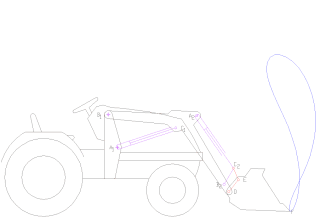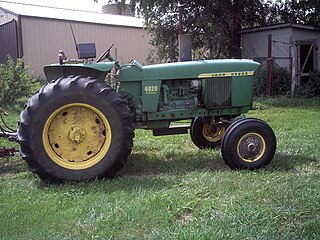Related Research Articles

The Unimog is a range of multi-purpose tractors, trucks and lorries that has been produced by Boehringer from 1948 until 1951, and by Daimler Truck since 1951. In the United States and Canada, the Unimog was sold as the Freightliner Unimog.

A tractor is an engineering vehicle specifically designed to deliver a high tractive effort at slow speeds, for the purposes of hauling a trailer or machinery such as that used in agriculture, mining or construction. Most commonly, the term is used to describe a farm vehicle that provides the power and traction to mechanize agricultural tasks, especially tillage, and now many more. Agricultural implements may be towed behind or mounted on the tractor, and the tractor may also provide a source of power if the implement is mechanised.

Deere & Company, doing business as John Deere, is an American corporation that manufactures agricultural machinery, heavy equipment, forestry machinery, diesel engines, drivetrains used in heavy equipment, and lawn care equipment. The company also provides financial services and other related activities.

A loader is a heavy equipment machine used in construction to move or load materials such as soil, rock, sand, demolition debris, etc. into or onto another type of machinery.

The International Harvester Company (often abbreviated by IHC, IH, or simply International was an American manufacturer of agricultural and construction equipment, automobiles, commercial trucks, lawn and garden products, household equipment, and more. It was formed from the 1902 merger of McCormick Harvesting Machine Company and Deering Harvester Company and three smaller manufactures: Milwaukee; Plano; and Warder, Bushnell, and Glessner. Its brands included McCormick, Deering, and later McCormick-Deering, as well as International. Along with the Farmall and Cub Cadet tractors, International was also known for the Scout and Travelall vehicle nameplates. In the 1980s all divisions were sold off except for International Trucks, which changed its parent company name to Navistar International.

Farmall was a model name and later a brand name for tractors manufactured by International Harvester (IH), an American truck, tractor, and construction equipment company. The Farmall name was usually presented as McCormick-Deering Farmall and later McCormick Farmall in the evolving brand architecture of IH.

An articulated hauler, articulated dump truck (ADT), or sometimes a dump hauler, is a very large heavy-duty type of dump truck used to transport loads over rough terrain, and occasionally on public roads. The vehicle usually has all-wheel drive and consists of two basic units: the front section, generally called the tractor, and the rear section that contains the dump body, called the hauler or trailer section. Steering is made by pivoting the front in relation to the back by hydraulic rams. This way, all wheels follow the same path, making it an excellent off-road vehicle.

The Lanz Bulldog was a series of tractors manufactured by Heinrich Lanz AG in Mannheim, Baden-Württemberg, Germany. Production started in 1921 with the Lanz HL, and various versions of the Bulldog were produced up to 1960, one of them being the Lanz Bulldog D 9506. John Deere purchased Lanz in 1956 and started using the name "John Deere Lanz" for the Lanz product line. A few years after the Bulldog was discontinued the Lanz name fell into disuse. The Lanz Bulldog was one of the most popular German tractors, with over 220,000 of them produced in its long production life. The name "Bulldog" is widely used in Germany as a synonym for tractors even today, especially in Bavaria.

The John Deere 4020 was an agricultural tractor model made by John Deere from 1964 to 1972. It replaced the nearly identical 4010 that had been introduced with Deere's New Generation series in 1960 and offered a number of improvements over the previous model including more horsepower, heavier rear axles, and a differential lock. The 4020 was produced with three engine options: diesel, petrol, and LPG. The 4020 Diesel has a six-cylinder engine tested at 84 drawbar and 91 PTO horsepower. John Deere's Syncro Range transmission with 8 forward speeds and two reverse speeds was standard, a power shift transmission was optional. Other options included dual rear wheels and an enclosed cab with heat and air conditioning. The 4020 is significant for its great popularity; over 184,000 units were built. It was the most popular tractor of its time.

The John Deere Model A is a row crop tractor manufactured by Deere & Company. The A was produced in a wide variety of versions for special-purpose cultivation. It received a styling upgrade in 1939 and electric starting in 1947. With the advent of John Deere's numerical model numbering system, the A became the John Deere 60, and later the 620 and 630, 3010, 3020, 4030, 4040, 4050, 4055, and ended with the 7610.

The Unimog 406 is a vehicle of the Unimog-series by Mercedes-Benz. A total of 37,069 units were manufactured by the Daimler-Benz AG in the Unimog plant in Gaggenau from 1963 to 1989. The 406 was the first medium duty Unimog, having a larger wheelbase of 2380 mm and more than twice the engine power of the Unimog 401. Unlike the initial Unimog, the 406 does not have a car engine but a heavy duty truck engine instead. Several following Unimog versions were based on the 406. There were eleven different types made of the Unimog 406, which were available in four models with a closed two-door or four-door cab, as Cabrio and as an OEM part. During its long production period, the 406 received several technical refinements. In 1964, the precombustion chamber diesel engine OM 312 was replaced with the direct injected OM 352. Disc brakes followed in 1973. For many enthusiasts, the Unimog 406 represents the classical Unimog, having agricultural and silvicultural applications. It was successful and the best embodiment of the word Universal-Motor-Gerät considering all prior Unimogs.
The Farmall 04 series tractors are a family of row-crop tractors with four-cylinder engines, continuing the tradition of four-cylinder engines in Farmall and parent company International Harvester for general-purpose and row-crop tractors. In the early 1960s demand for more power led to the 06 series with six-cylinder engines. Four-cylinder engines were reserved for tractors equivalent to the Farmall H and smaller.

The Farmall 06 series tractors are a family of row-crop tractors with six-cylinder engines, providing greater horsepower than the parallel product line of four-cylinder Farmall 04 series tractors. Until the late 1950s, Farmall and parent company International Harvester tractors used four-cylinder engines for general-purpose and row-crop tractors. Demands for higher performance and greater horsepower led to broader use of six-cylinder engines, with the bulk of International's production moving to the larger engines. The Farmall 806 and 706 were introduced in 1963, with production running to 1967. The Farmall 1206 was introduced in 1965 as the most powerful tractor of its time, using a turbocharged diesel engine. Production of the 1206 also ran until 1967. The 06 series sold well and was regarded as extremely successful.

The John Deere Model GP tractor was a two-plow, and later a three-plow row-crop tractor produced by John Deere from 1928 to 1935. Initially called the John Deere Model C, the name was changed to GP as a result of difficulties in distinguishing between the Model C and Model D over the telephones of the time. It was intended as a response to the Farmall Regular line of general-purpose tractors produced under the Farmall brand by International Harvester..

The John Deere Model B tractor was a two-plow row-crop tractor produced by John Deere from 1935 to 1952, with direct successors produced until 1960. The B was a scaled-down, less expensive version of the John Deere Model A. It was followed by the updated 50, 520 and 530 models.

The John Deere Model G tractor was a large three-plow row-crop tractor produced by John Deere from 1937 to 1953, with successor models produced until 1961.It was followed by the updated 70, 720 and 730 models.

The John Deere Model M tractor was a two-cylinder row-crop tractor produced by John Deere from 1947 to 1952, with successor models produced until 1960. It was succeeded by the updated 40, 420 and 430 models, as well as the 320 and 330 models that occupied the market positions left vacant by the more powerful 400 series models.

The John Deere Model R tractor was John Deere's first diesel tractor. A large, heavy tractor, it had fixed wheel widths and was not produced as a row-crop tractor with adjustable axles. The R was followed in the John Deere numbered model series by the John Deere 80, 820 and 830 tractors, which represented evolutionary upgrades to the basic R.

The Oliver Super 55 series of utility tractors was developed and produced from 1954 to 1975 by the Oliver Farm Equipment Company to complement the Oliver line of heavy row-crop and standard agricultural tracts. Like row-crop tractors, the wheel track width could be adjusted to conform to crop row spacing, but the front wheels were only offered with a wide track. No narrow front wheel options were offered, making the tractor more stable with front-end loaders.
References
- ↑ "John Deere 435". TractorData. Retrieved 19 October 2014.